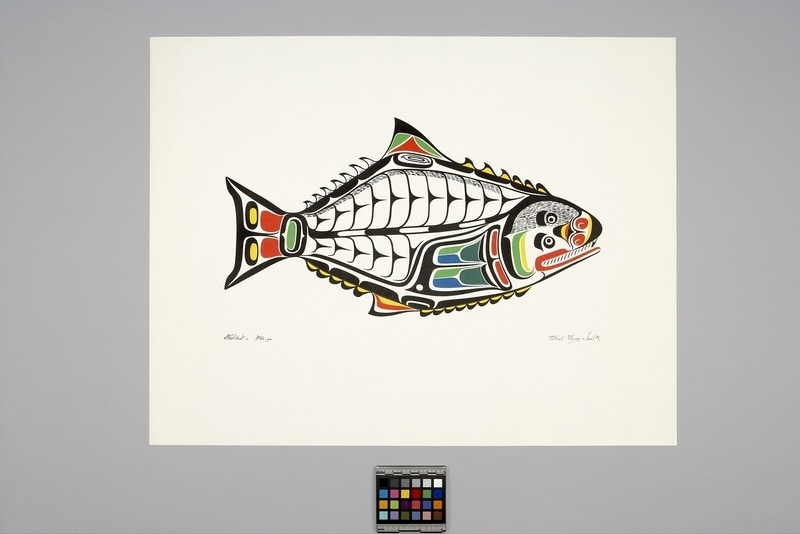Halibut, Poh-Ye Item Number: Nb3.1342 from the MOA: University of British Columbia

Description
Profile of a halibut outlined in black in Kwakwaka'wakw style. Main portion of the body is split black and white u forms. Tail has two red u forms with two black ovoids above them, the centre of which is yellow. Where the tail and body connect, there is an ovoid with a green ovoid at the centre. There are two multi-coloured fins with the bottom one in blue, green, light green, and red ovoids, u forms, and split u's. One half of the head is dashed with black lines and the other half is white with two lines in yellow and light green. Mouth and nostrils are red. There are scales on top of the outlines of the body and on the bottom. Black inscription below image. The print is on vertically rectangular, off-white paper.
History Of Use
Northwest Coast print making is a relatively new art form, which began in the late 1940's, but did not develop until the late 1960's. The establishment of the Northwest Coast Indian Artists Guild, in 1977, aided the implementation of standards in limited addition runs and various aspects of quality control. Silk-screen prints have been used to portray traditional and contemporary themes, as well as, to make personal statements. Kwakwaka'wakw artists have, in general, preferred to work with traditional crest designs and mythical themes. More colours are used by Kwakwaka'wakw artists than are used by northern Northwest Coast artists, and the images are composed of many small elements combining into relatively realistic forms.
Cultural Context
contemporary art
Iconographic Meaning
Kwakwaka'wakw legend says that a halibut stranded at the mouth of the Nimpkish River after the great flood subsided, threw off his skin, tail and fins to become the first man. Identifying characteristics of halibuts are 2 eyes on top of head, off-centred, the mouth is to one side, oval body edged with a fin, and a spread out tail.
Narrative
Nb3.1335 to Nb3.1343 were given to Audrey Hawthorn in 1973. This collection of Henry Speck prints is from an unnumbered collection probably printed in the 1960's.
Item History
- Made by Chief Henry Speck (Maker) in British Columbia, Canada during 1962
- Collected during 1973
- Owned by Audrey Hawthorn before June 21, 1976
- Received from Audrey Hawthorn (Donor) on June 21, 1976
What
- Name
- Halibut, Poh-Ye
- Identification Number
- Nb3.1342
- Type of Item
- Manufacturing Technique
- silkscreened
- Overall
- height 48.2 cm, width 62.3 cm, depth 0.1 cm
Who
- Culture
- Kwakwaka'wakw
- Creator
- Chief Henry Speck (Maker)
- Previous Owner
- Audrey Hawthorn
- Received from
- Audrey Hawthorn (Donor)
Where
- Holding Institution
- MOA: University of British Columbia
- Made in
- British Columbia, Canada
When
- Creation Date
- during 1962
- Collection Date
- during 1973
- Ownership Date
- before June 21, 1976
- Acquisition Date
- on June 21, 1976
Other
- Item Classes
- works on paper
- Condition
- fair
- Accession Number
- 0309/0014